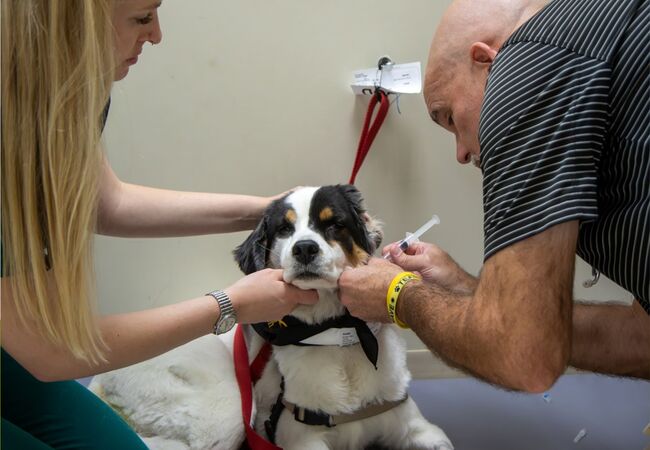When Your Dog Is Diagnosed with Cancer: Veterinary Guide & Aftercare 2025 🩺🐾

In this article
When Your Dog Is Diagnosed with Cancer: Veterinary Guide & Aftercare 2025 🩺🐾
By Dr. Duncan Houston BVSc
Hello, I’m Dr Duncan Houston BVSc, veterinarian and founder of Ask A Vet. Hearing “your dog has cancer” is difficult—but modern veterinary oncology offers hope. In this comprehensive 2025 guide, I’ll walk you through every stage: understanding diagnosis, planning treatments, navigating prognosis, providing aftercare, managing costs, and using supportive tools like Ask A Vet to maintain your dog’s quality of life. Let’s begin this journey together 🐶💙
1. Understanding the Diagnosis & Staging 🔍
After a suspicious lump or symptom, your vet may recommend:
- Biopsy or cytology to type the cancer
- Staging tests: bloodwork, chest X-rays or CT, abdominal ultrasound, bone marrow aspirates—to determine spread and stage.
Why staging matters: size (T), lymph node involvement (N), and metastasis (M) inform treatment choices and prognosis. The early stage means more treatment options and better outcomes.
2. Treatment Options & Planning 🛠️
2.1 Surgery
Often the first step for solid tumors to remove or “debulk” cancer. Best outcomes when margins are clean. Recovery usually takes ~2 weeks.
2.2 Chemotherapy
Common protocols include single agents like carboplatin or doxorubicin—or combinations for lymphoma (e.g., CHOP). Chemo aims for remission and tumor control, not necessarily cure.
Side effects—mild nausea, appetite changes, fatigue—are typically manageable. Dogs rarely lose all their fur.
2.3 Radiation Therapy
Targeted for tumors that can’t be removed or as an adjunct to surgery. Common for brain tumors, mast cell tumors, or incompletely excised lesions.
2.4 Immunotherapy & Targeted Therapy
The concept vaccine for melanoma is an example. Targeted therapies like masitinib and toceranib are used for mast cell tumors.
2.5 Palliative & Supportive Care
When curative treatment isn’t feasible, palliative care focuses on relief—pain control, appetite, and comfort. This may include surgery, chemo, steroids, or NSAIDs to maintain quality of life.
3. Prognosis & Realistic Expectations 📊
The prognosis depends on:
- Cancer type: lymphoma offers the potential for remission with chemo (average 9–12 months, sometimes longer).
- Mast cell tumors: localized cases can achieve high survival—≥1-year disease‑free with surgery ± radiation.
- Hematopoietic cancers: stage, grade, subtype important—B-cell lymphoma typically fares better than T-cell.
- Hemangiosarcoma: very aggressive—surgery alone yields 1–3 months; chemo may add another 2–4 months.
- Brain/lung tumors: primary lung tumors post-surgery average 12–18 months; metastases shorten survival.
Some aggressive cancers may offer only a few months even with treatment—honest conversations with your vet are vital.
4. Side Effects & Monitoring 🩺
- Chemo effects: mild GI upset, fatigue—anti-nausea meds can help.
- Bloodwork: helps track bone marrow and kidney function.
- Radiation side effects: skin irritation or fatigue—usually well tolerated.
- Signs needing vet care: loss of appetite, vomiting, diarrhea, fever, lethargy—prompt evaluation can prevent complications.
5. Aftercare & Enhancing Quality of Life ❤️
5.1 Nutrition & Exercise
- Digestible, protein-rich diets support healing during chemo or radiation.
- Gentle exercise: slow walks, and soft play to maintain muscle, mood, and digestion.
5.2 Pain Management
- NSAIDs, gabapentin, and opioids for cancer-related pain, as needed.
- Comfortable bedding, warm spots—simple things improve well-being.
5.3 Emotional Support
- Routine and calm environments reduce stress.
- Toys, soft treats, and gentle petting improve mood and quality of life.
- Medication adjustments (e.g., prednisone) can improve appetite and comfort.
6. Financial Planning & Insurance 💰
Cancer treatments vary in cost—from a few thousand for surgery to multiple rounds of chemo and radiation reaching several thousand dollars.
- Pet insurance: can offset treatment costs—choose plans without low coverage limits.
- Palliative-only options exist for owners with limited budgets.
- Discuss payment plans or charitable clinics if cost is a concern.
7. Making the Tough Decisions 🧭
If short-term survival is unlikely and suffering is high, euthanasia may be the most caring choice. A palliative approach can ease discomfort in the final days.
A tough but loving question: are we treating for our needs or theirs? Honest heart-to-heart with your vet can make a difference.
8. Tools & Support Systems 💡
- Ask A Vet: Teleconsults for symptoms, monitoring, and treatment questions.
9. Coping & Caregiver Support 🧸
Caring for a sick pet is emotionally draining. Reach out to friends, vets, or online communities. Palliative care support groups can help you feel less alone.
10. Final Thoughts 📝
Dog cancer is difficult—but modern veterinary care in 2025 offers meaningful treatment options that balance hope with realistic expectations. By combining oncology, supportive care, and tools like Ask A Vet you can give your dog the best quality of life possible—every day matters. 🐾💙
Unsure what to do next? Schedule a telehealth consult at AskAVet.com and download our app to begin tracking care, symptoms, and treatment reminders. Let’s navigate this together. 🌟


